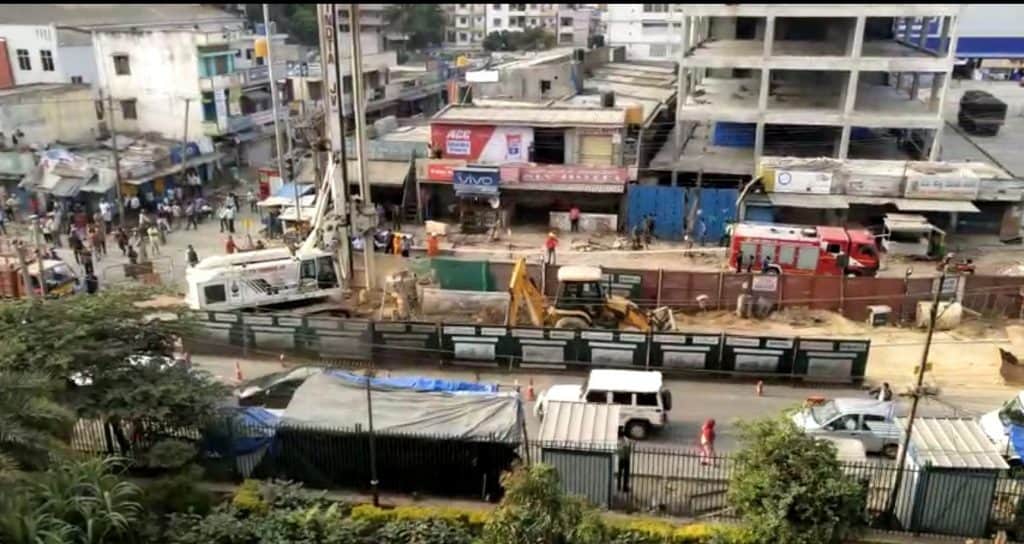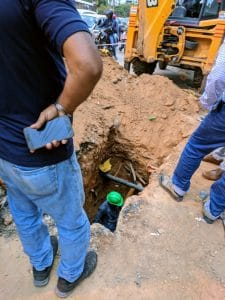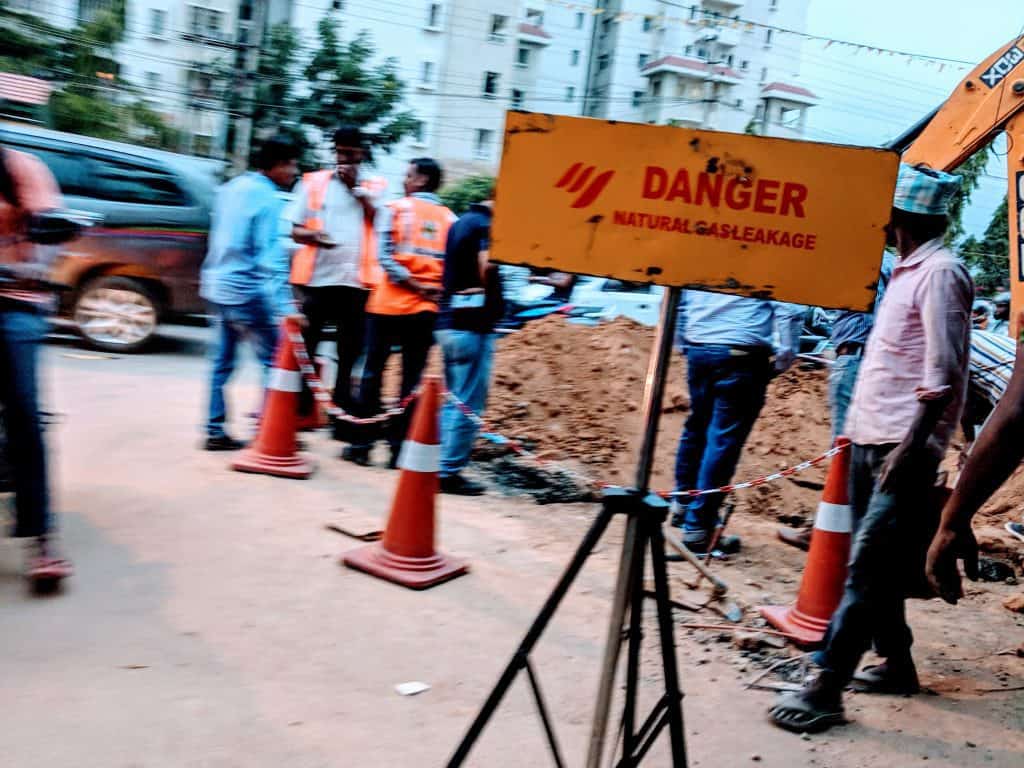The morning of October 29, 2018 saw chaos on the ITPL main road at Whitefield in Bengaluru, when the Gas Authority of India Ltd. (GAIL) natural gas pipeline sprung a leak in front of Decathlon during BMRCL operations. The Bengaluru Traffic Police tweeted that the traffic had been diverted to accommodate the repair teams. By 10 am, it was announced by the GAIL DGM Operations, Senthil Kumar that the leak was plugged. While there was a lot of talk about the traffic situation it caused, the accident raises several questions about safety and more importantly about what lies below Bangalore’s roads.

A grab from the video from the location, circulated by Bengaluru City Traffic Police.
P Murugeshan, Executive Director, GAIL India Ltd, told this reporter that the leak was identified at around 7 am on Monday. “We have patrol teams in the area and they identified the leak because the methane, which in its pure form is an odourless gas, has been odorised. The team was strengthened with more experts rushing to the spot. The valve was isolated and vented immediately through the District Regulating Station (DRS) that was close by and the leak was plugged,” said the official.
AK Mathur, Executive Director, Whitefield -Byappanahalli stretch, BMRCL told this reporter that leak was identified at around five in the morning and the GAIL team immediately worked towards plugging the leak to ensure that disaster did not ensue.
Why wasn’t Metro aware of the gas pipeline?
The damaged distribution line which is a part of the mainline of Piped Natural Gas (PNG) from Dabhol to Bangalore running in a 30 km stretch between K R Puram and Hoskote covering areas around ITPL and beyond. The pipes are usually laid at a depth of 1.2 meters under the road. But this line ran about 3 meters below the road. “Since we do trench-less laying of pipes, this has gone a little deeper. But with regard to safety, the deeper the line is, the safer it stays because it doesn’t come in contact with anybody. However if the BMRCL had asked us, we would have told them there was a pipe there,” said Murugeshan.
Bangalore Metro Rail Corporation Ltd (BMRCL) however defended themselves. “Usually before we undertake any work on a stretch, we do ‘trenching’. It is done once before the Tendering and then the contractor does a second round a couple of months before he starts work. Trenching basically is about mapping all the utilities under the road stretch. We go as deep as 2.5 meters, find out what utilities exist under there, get in touch with the corresponding departments, reroute them as needed. In this case, the pipe was at a depth of about 3.1 meters and at the centre of the road. Every other stretch where there has been GAIL pipeline, they were laid on the side of the roads. We have no idea how this line made it to the centre of the road.” says Mathur.
The BMRCL official also added that despite all the precaution they take to map the utilities, since there is no centralised database for the networks, there are always surprises. “Sometimes even when we have the maps of the utilities network, they don’t match, because they aren’t updated to reflect new additions or rerouting” says Mathur.

A GAIL gas leak being attended to at Sarjapur Road, June 2018
There have been other examples of minor gas leaks in the GAIL pipeline in Sarjapur Road, but they never hit the headlines so far.
What is this pipeline and how safe is it?
The Dabhol – Bangalore Piped Natural Gas (PNG) runs through two states of Maharashtra and Karnataka for about 1,386km and connects South India to the national gas grid. It was commissioned in 2013 during the 8th Asia Gas Partnership Summit (AGPS). The damaged pipe is a distribution line that is part of the City Gas Distribution (CGD) Project to supply Piped Natural Gas (PNG) to replace the more expensive LPG. Methane which is main component of the PNG is highly inflammable and used in cooking and heating needs. The CGD is five year project, the first year seeing supply to ITPL and OBCL, Peenya, Kamalanagar, Hennur, BEL, BHEL, HSR Layout, Jindal and IISc.

A GAIL gas leak being attended to at Sarjapur Road, June 2018. Pic: Meera K
What are the safety precautions and protocols? The pipeline is monitored online through pressure sensors to keep a check on leaks. The mainline pipe running through the Outer Ring Road is 18 inches wide and made of steel. The 5 inch pipes that pass through residential area is made of Medium density polyethylene. The pressure of gas which is 19 bar on the steel pipe that passes through ORR, is reduced to 4 bar when it passes through MDP pipe. This will be further regulated and reduced to 21 millibar when it enters the kitchens and it is safe enough. All the pipes except the one that enters the kitchen will be underground and safely guarded with protective structures.
Now the blame game starts between two of them.. ultimately people are the one who are suffered always.. now if the gail line was already present then why did they allow metro alignment on top of that or close to pipe line.. is it because of the lobby of so called politician, builders and who else?
Nagawara to Airport metro line re routed to via Hebbal canceling RK Hegde Nagar, reason was “due to gas line it was not safe to build Metro line”. How come this plan was sanctioned. People in Whitefield are fire resistant or what?
The Nagavara line was an underground one and thus posed a higher risk to damaging the pipelines. And I believe the metro near Hebbal will go above ground while crossing the gas pipeline. This Whitefield route is above ground.
Hegde Nagar to kogilu cross line has a oil pipe not gas, and it is a large oil pipe apparently.
It still evades me how can GAIL not have GIS details of high pressure transmission gas line (steel 8 inch) and put enire blame on BMRCL. Gas at 19 bar can blow away entire neighborhood. I hope people realize the risks involved and press for safety measures.